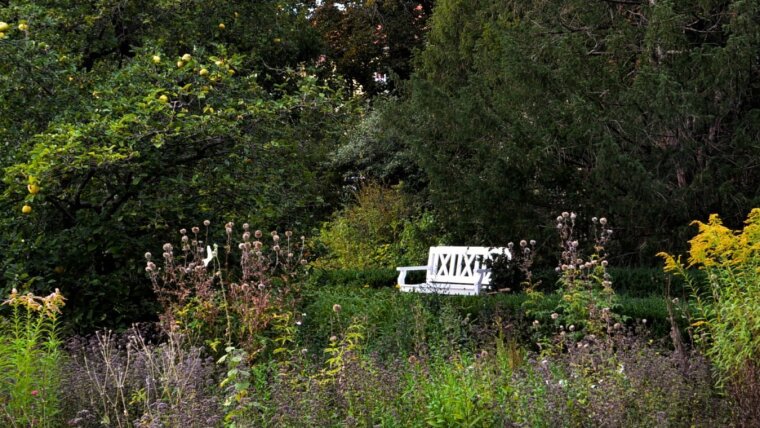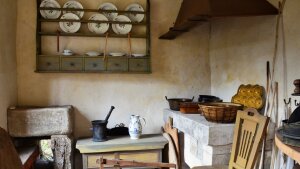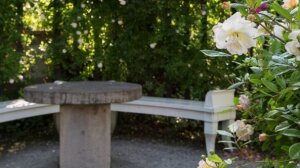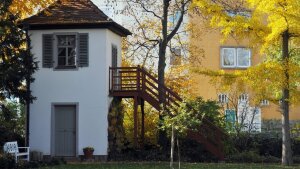
A detailed picture of the layout of the garden is provided by a watercolor ground plan drawing that the student Dietrich Christian August Steinhaus made for Schiller in 1799. This document shows that the garden was divided by a central axis running east-west from the door of the garden house to the arbour. The rear part of the property was densely planted with fruit trees, which produced a plentiful harvest in the fall. Their yield also benefited the poet's family. There is evidence of a plum harvest in which Schiller shook the tree and his son Karl picked the fruit from the ground. Charlotte Schiller had a vegetable garden planted near the house, where she grew asparagus and chard, among other things. Schiller often praised the roses and lilies that bloomed in his garden - a combination of flowers that, according to a contemporary, he particularly appreciated.
Interior view of the kitchen building out in the garden
Image: Fiona DaffnerKitchen and monument
In the fall of 1797, Schiller arranged the construction of a “completely custom-built” kitchen, separate from the house, in which meals were prepared for the family during the next stays. Although an extension to the garden house would probably have been more suitable for this purpose, Schiller deliberately insisted on the location in the north-western corner of the estate. We can only speculate the reasons for this. The intention to keep all the mundane business of the household as far away as possible from the living and working spaces probably played a role. A statement made by his sister-in-law Caroline von Wolzogen fits in with this: “I love very much”, said Schiller, “that the housekeeping is done properly; but I don't like to hear the creaking of the wheels.” Not far from the kitchen is a heavily weathered monument made of sandstone. Its original location was on the steep slope down to the Leutra stream, which at the time formed the western boundary of the property. The law professor Johann Ludwig Schmidt, who owned the garden before Schiller from 1766 to 1792, had it erected in memory of his deceased wife.
Steintisch mit Originalplatte aus Muschelkalk
Image: Schillers GartenhausStone table and pergola
The garden has always been a place for socializing and intellectual exchange. Among the many visitors in the years before 1800 were Caroline von Humboldt, Sophie Brentano, Susette Gontard, Ludwig Tieck, Johann Gottlieb Fichte and Friedrich Wilhelm Joseph Schelling. In pleasant weather, Schiller received his guests in a pergola densely overgrown with dog roses. Evening conversations with Goethe, who met Schiller in the garden almost every day during his stays in Jena, also took place at the stone table with its oval slab of shell limestone. Remembering this, Goethe told Johann Peter Eckermann in October 1827 on the occasion of his last visit: “In this pergola, on these now almost collapsed benches, we often sat at this old stone table and exchanged many a good and great word.”
Die »Gartenzinne« im Herbst
Image: Schillers GartenhausThe »garden pinnacle«
In the summer of 1798, Schiller had the garden hut in the south-west corner of the estate raised by one storey. The resulting room, which was reached via a wooden staircase, offered a beautiful view of the Saale valley and the Leutra valley. Charlotte Schiller reported on the special charm of this place in a letter a few weeks after its completion: “A garden house has been built opposite the kitchen, which has a wonderful view of the Saale valley and the Leutra valley, where I take great pleasure in the moonlight to see the great masses of light and shadow that arise on the slope and white sandstone.”
The following summer, Schiller took advantage of the “good, friendly atmosphere” in the “little garden room” to work on his drama “Maria Stuart”. In the “Epilogue to Schiller's Bell”, Goethe referred to the “garden pinnacle”, as he called the little tower rising above the gorge of the Leutra , as Schiller's preferred retreat for writing. In March 1817, Goethe also made concrete proposals to create a memorial room for his deceased poet friend here. However, the lightly built pavilion was already so dilapidated that it had to be demolished shortly afterwards. In its place, the Jena physician Georg Dietrich Kieser had a granite block with the inscription “Here Schiller wrote Wallenstein” erected in 1846. The “garden pinnacle” was not rebuilt according to historical models until 1978/79.


